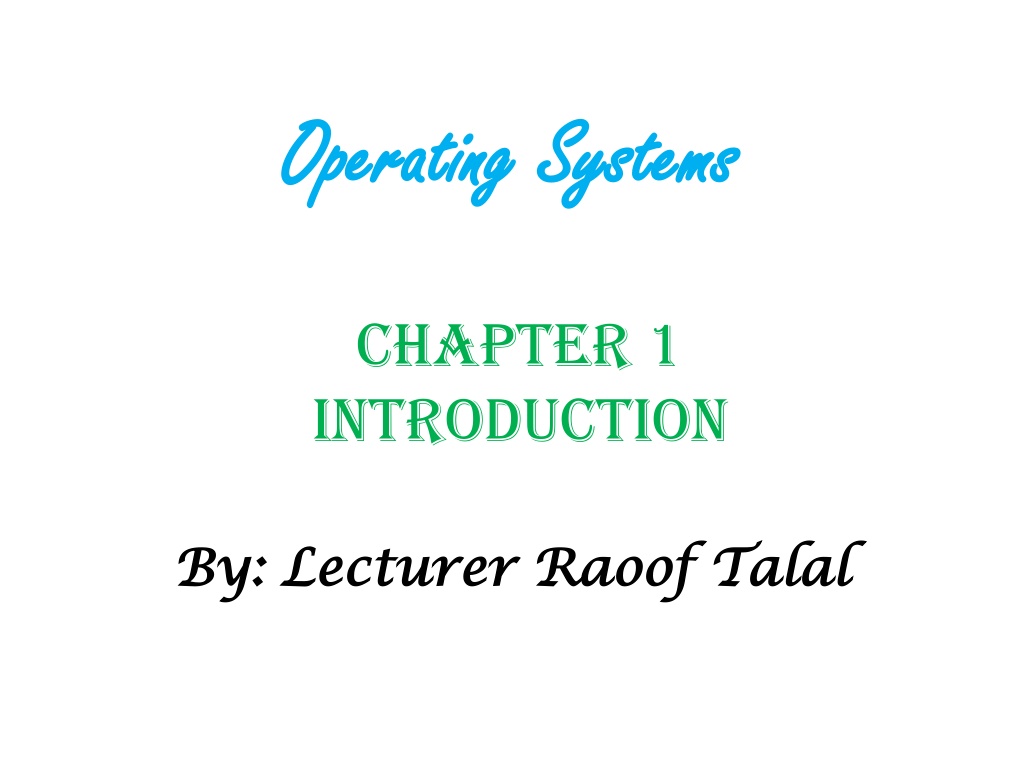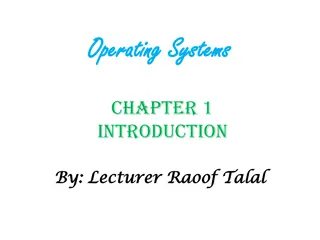Understanding Operating Systems: An Introduction and Overview
An operating system is a crucial program that manages computer hardware and serves as an intermediary between users and hardware. This chapter explores the role of operating systems in a computer system, covering components like hardware, application programs, and users. It delves into how operating systems control and coordinate hardware usage among various applications and users, highlighting the perspectives of both users and systems. The user's view focuses on ease of use, while the system view sees the operating system as a resource allocator and control program for efficient computer operation.
Download Presentation

Please find below an Image/Link to download the presentation.
The content on the website is provided AS IS for your information and personal use only. It may not be sold, licensed, or shared on other websites without obtaining consent from the author. Download presentation by click this link. If you encounter any issues during the download, it is possible that the publisher has removed the file from their server.
E N D
Presentation Transcript
Operating Systems Operating Systems Chapter 1 introduction By: Lecturer By: Lecturer Raoof Raoof Talal Talal
1.1 What are the Operating Systems? An operating system is a program that manages the computer hardware. It also acts as an intermediary between the computer user and the computer hardware. 1.2 What Operating Systems Do? We begin our discussion by looking at the operating system's role in the overall computer system. A computer system can be divided roughly into four components: the hardware, the operating system, the application programs, and the users.
The hardware: such as the central processing unit (CPU), the memory, and the input/output (I/O) devices provide the basic computing resources for the system. The application spreadsheets, compilers, and web browsers define the ways in which these resources are used to solve users' computing problems. programs: such as word processors, The operating system: controls and coordinates the use of the hardware among the various application programs for the various users.
To understand more fully the operating system's role, we next explore operating systems from two viewpoints: that of the user and that of the system. User View The user's view of the computer varies according to the interface being used. Most computer users sit in front of a PC, consisting of a monitor, keyboard, mouse, and system unit. Such a system is designed for one user to monopolize its resources. The goal is to maximize the work (or play) that the user is performing. In this case, the operating system is designed mostly for ease of use.
System View From the computer's point of view we can view an operating system as a resource allocator. A computer system has many resources that may be required to solve a problem: CPU time, memory space, file-storage space, I/O devices, and so on. The operating system acts as the manager of these resources. Facing numerous and possibly conflicting requests for resources, the operating system must decide how to allocate them to specific programs and users so that it can operate the computer system efficiently and fairly. A slightly different view of an operating system emphasizes the need to control the various I/O devices and user programs. An operating system is a control program. A control program manages the execution of user programs to prevent errors and improper use of the computer. It is especially concerned with the operation and control of I/O devices.
Therefor operating system is the one program running at all times on the computer (usually called the kernel), with all else being systems programs and application programs.
1.3 Computer-System Organization 1.3.1 Computer-System Operation A modern general-purpose computer system consists of one or more CPUs and a number of device controllers connected through a common bus that provides access to shared memory (Figure 1.2). Each device controller is in charge of a specific type of device (for example, disk drives, audio devices, and video displays). To ensure orderly access to the shared memory, a memory controller is provided whose function is to synchronize access to the memory.
For a computer to start runningfor instance, when it is powered up or rebooted it needs to have an initial program to run. This initial program, or bootstrap program, tends to be simple. Typically, it is stored in read-only memory (ROM) or electrically erasable programmable (EEPROM), known by the general term firmware, within the computer hardware. It initializes all aspects of the system, from CPU registers to device controllers to memory contents. The bootstrap program must know how to load the operating system and to start executing that system. To accomplish this goal, the bootstrap program must locate and load into memory the operating system kernel. The operating system then starts executing the first process, such as "init," and waits for some event to occur. read-only memory
The occurrence of an event is usually signaled by an interrupt from either the hardware or the software. Hardware may trigger an interrupt at any time by sending a signal to the CPU usually by way of the system bus. Software may trigger an interrupt by executing a special operation called a system call (also called a monitor call). When the CPU is interrupted, it stops what it is doing and immediately transfers execution to a fixed location. The fixed location usually contains the starting address where the service routine for the interrupt is located. The interrupt service routine executes; on completion, the CPU resumes the interrupted computation.
1.3.2 Storage Structure Computer programs must be in main memory (also called random-access memory or RAM) to be executed. Main memory is the only large storage area (millions to billions of bytes) that the processor can access directly. It commonly is implemented in a semiconductor technology called dynamic random- access memory (DRAM), which forms an array of memory words. Each word has its own address. Interaction is achieved through a sequence of load or store instructions to specific memory addresses.
Ideally, we want the programs and data to reside in main memory permanently. This arrangement usually is not possible for the following two reasons: 1. Main memory is usually too small to store all needed programs and data permanently. 2. Main memory is a volatilestorage device that loses its contents when power is turned off or otherwise lost
Thus, most computer systems provide secondary storage as an extension of main memory. The main requirement for secondary storage is that it be able to hold large quantities of data permanently. The most common secondary-storage device is a magnetic disk, which provides storage for both programs and data. In a larger sense, however, the storage structure such as registers, main memory, and magnetic disks is only one of many possible storage systems. Others include cache memory, CD-ROM, magnetic tapes, and so on. Each storage system provides the basic functions of storing a datum and of holding that datum until it is retrieved at a later time. The main differences among the various storage systems lie in speed, cost, size, and volatility.
The wide variety of storage systems in a computer system can be organized in a hierarchy (Figure 1.3) according to speed and cost. The higher levels are expensive, but they are fast. As we move down the hierarchy, the cost per bit generally decreases, whereas the access time generally increases. This trade-off is reasonable; if a given storage system were both faster and less expensive than another other properties being the same then there would be no reason to use the slower, more expensive memory. Now, the magnetic tape and semiconductor memory have become faster and cheaper. The top four levels of memory in (Figure 1.3) may be constructed using semiconductor memory. Another form of electronic disk is flash memory, which is popular in cameras and personal digital assistants (PDAs), in robots, and increasingly as removable storage on general-purpose computers.























